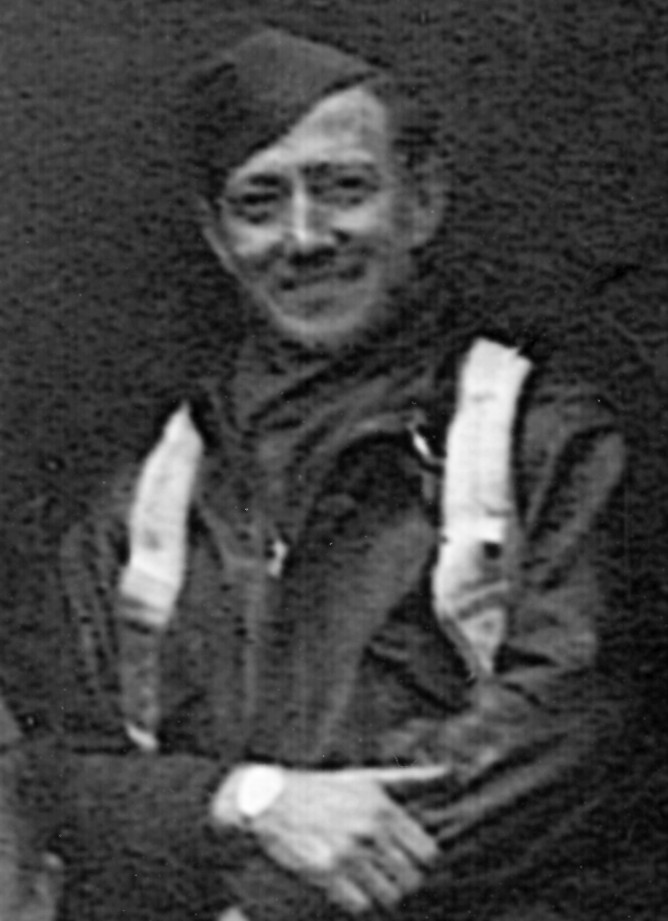Lloyd E. Everett was born in Mississippi on April 11, 1921, and resided in Pike County, Mississippi. His parents were Micajah Cicero Everett (15 Aug 1888 24 Apr 1950) and Ethel V. (Lyons) Everett (13 Jun 1897 23 Dec 1992). He had two brothers, Marshall C. Everett (abt 1919 unk) and William Rex 'Billy' Everett Sr (4 Oct 1924 1 Sep 2004). In 1930 the family lived on East Meadville Street in Summit, Pike County, Mississippi, and his paternal grandfather, William A. Everett (abt 1850 unk), lived with the family. His father worked as a machinist in a railroad shop. Lloyd Everett completed three years of high school and worked as a semiskilled mechanic and repairman. He was married to Mary Belle (Jones) Everett when he enlisted in the U.S. Army at Camp Shelby, Mississippi on November 9, 1942. He was 5 feet 5 inches tall, weighed 107 pounds, had grey eyes and brown hair, and shoe size 6C. His home of record was 621 Avenue F, McComb, Mississippi, his wife's address in 1944.
After training, he was assigned as flight engineer and aerial gunner on the heavy bomber crew of Lt David L. Ozbolt, in the 839th Bomb Squadron of the 487th Bomb Group. The Ozbolt crew completed B-24 combat crew training with the 487th Bomb Group at Alamogordo Army Air Base, New Mexico, and deployed with the Group to England in March 1944. The 487th Bomb Group was based at Army Air Forces Station 137, near the village of Lavenham, Suffolk, England, and was part of the 8th U.S. Army Air Force in Europe.
On July 20, 1944, the Ozbolt crew was flying B-24H 42-51197 on a practice bombing mission near its base, when it collided with another aircraft, B-17G 43-37840, that was also on a training mission. S/Sgt Everett bailed out and survived, but five of his crew mates, including pilot Lt Ozbolt, were killed.
S/Sgt Everett was reassigned as ball turret gunner on the crew of 1st Lieutenant Joseph A. Duncan, in the 839th Bomb Squadron of the 487th Bomb Group. In July 1944 the 487th Bomb Group transitioned to flying the B-17 'Flying Fortress'. On August 25, 1944, the Duncan crew took off from Lavenham Airfield in B-17G 43-37980 on a mission to bomb the German airfield at Rechlin, Germany. Captain Winston S. Rogers flew in the copilot position as Air Leader. Copilot Lt James Hood Jr moved to the tail gunner postion as Officer Tail Gunner and formation observer. S/Sgt Everett and eight of his crew mates were killed in action when their aircraft was hit by flak just after bombs away over Rechlin, Germany. The right outer wing was lost, and the burning aircraft went into a spin, exploded, and crashed in Muritz Lake (Mόritzsee) near Boek, Germany, north of the target. Two crew members, 1/Lt Joseph Anderson Duncan and S/Sgt Monroe Stanley Wolyn, were blown clear and survived. Lt Hood's body was never found. He probably went to the bottom of Muritz Lake with the aircraft wreckage.
Here is Lt Duncan's crew:
Duncan, Joseph A 1/Lt Pilot POW
Rogers, Winston S Capt Air Leader KIA
Jones, Richard L Capt Pilotage Navigator KIA
Friedman, Ely N 2/Lt Navigator KIA
Dolan, James J 2/Lt Bombardier KIA
Henahan, Joseph W T/Sgt Engineer KIA
Brown, Gerard F T/Sgt Radio operator KIA
Everett, Lloyd E S/Sgt Ball Turret Gunner KIA
Brown, Rhodes L S/Sgt Waist Gunner KIA
Wolyn, Monroe S S/Sgt Waist Gunner POW
Hood Jr, James 2/Lt Tail Gunner MIA
The body of S/Sgt Everett was recovered on the shore of Muritz Lake on September 20, 1944. His remains and those of seven of his crew mates were buried initially at the Retzow Cemetery in Retzow, Mecklenburg-Vorpommern, Germany, a short distance north of Rechlin Airfield. His remains were disinterred from Retzow Cemetery on 17 July 1947, moved to the Ardennes American Cemetery in Neuville-en-Condroz, Belgium. His remains were returned to the United States aboard USAT Haiti Victory. The ship departed Antwerp Harbor, Belgium, on April 22, 1949, and arrived at the New York Port of Entry on May 4, 1949. The remains were shipped by train to Mississippi, and reinterred at his final resting place in the Hollywood Cemetery in McComb, Mississippi.
Source of information: Paul M. Webber, www.findagrave.com

